Meet Our Students
MPUTC Students
Fu-Der Chen
Fu-Der Chen
Fu Der Chen received his BASc and MASc degrees in electrical and computer engineering from the University of Toronto in 2017 and 2019, respectively. He is currently a third-year Ph.D. student in the joint Ph.D. program from Max Planck-University of Toronto Centre (MPUTC) for Neural Science and Technology. His research goal is to design photonics microchips using an integrated photonics platform for large-scale stimulation and monitoring brain activity. The success of his work can provide neuroscientists with new tools to further advance the fundamental understanding of the brain.
MPUTC Project:
MPG Supervisor: Joyce Poon, MPI: Microstructure Physics
U of T Supervisor: Taufik Valiante, U of T Department: Electrical and Computer Engineering
Thesis topic: Integrated neural probes combining electrophysiology and photonics
Research Theme: To develop novel tools to observe and stimulate neural activity
Project description:
In this thesis, the student designs and characterizes implantable probes for the stimulation and recording of brain activity. The student works closely with our foundry partner, Advanced Micro Foundry, for the fabrication of these probes in a 200mm silicon process. In collaboration with neuroscientists, the functionality of the probes will be validated in tissues and animals. This is a highly challenging and multidisciplinary effort that will require excellent theoretical and practical experience in electromagnetics, electronics, semiconductors, and computational analysis. Excellent organizational and communication skills are also required due to the large number of collaborators involved. An openness to learn new skills and new disciplines is a must!
David Roszko

David Roszko
David is interested in the design, characterization, and application of novel neural interface technologies for monitoring and modulating the nervous system. David completed his BSc degree in electrical engineering and MSc degree in neuroscience at the University of Alberta, Alberta, Canada. His research has focused on developing and characterizing intraspinal neuroprostheses for restoring mobility in models of severe spinal cord injury by applying targeted electrical stimulation in the lumbosacral spinal cord. At the Max Planck-University of Toronto Centre (MPUTC) for Neural Science and Technology, David aims to develop nanophotonic neural probes for facilitating chronic optogenetic research in mouse models of epilepsy.
MPUTC Project:
MPG Supervisor: Joyce Poon, MPI: Microstructure Physics
U of T Supervisor: Taufik Valiante, U of T Department: Electrical and Computer Engineering
Thesis topic: High-density nanophotonic neural probes for mouse models of epilepsy
Research Theme: To develop novel tools to observe and stimulate neural activity
Project description:
In this thesis, the student will design and characterize high-density nanophotonic neural probes for facilitating optogenetic research in mouse models of epilepsy. Chronic implants will be designed to monitor and stimulate brain activity over time. Neuronal networks will be characterized throughout epileptogenesis to assess how neural diversity is lost during epilepsy. Novel stimulation paradigms will be investigated for modulating epileptic neural networks and preventing seizures. The student will work closely with scientists and postdocs at the MPI and University Health Network for designing these sophisticated devices and completing all in vivo experiments. This is a highly challenging and multidisciplinary effort that will require excellent theoretical and practical experience in electromagnetics, electronics, semiconductors, computational analysis, and neuroscience. Excellent organizational and communication skills are also required due to the large number of collaborators involved. An openness to learn new skills and new disciplines is a must!
Pamina Laessing
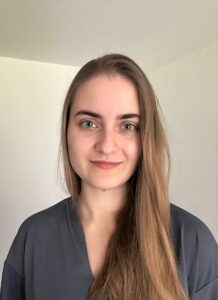
Pamina Laessing
Pamina is a physicist by trait and received her B.Eng. and M.Sc. in Engineering Physics from the University of Oldenburg in 2018 and 2021. She is interested in the pathophysiological brain mechanisms underlying psychiatric disorders. At the Max Planck – University of Toronto Centre (MPUTC) for Neural Science and Technology, Pamina does research to formulate and validate biologically informed computational models of suicidality. The goal of the project is a refined mechanistic, neurobiological understanding of suicidal thoughts and behaviours to improve early detection and treatment selection in individuals at risk.
MPUTC Project:
MPG Supervisor: Peter Dayan, MPI: Biological Cybernetics
U of T Supervisor: Andreea Diaconescu & Sean Hill, U of T Department: Institute for Medical Sciences
Thesis topic: Neurocomputational models of escape and avoidance for suicide prevention
Research Theme: To analyze data, create models and make predictions about neural activity
Project description:
Suicide is the second leading cause of death among young adults. Decades of research have sought to identify risk factors and treatment targets, but success has been elusive, with the pathophysiological brain mechanisms associated with suicidal thoughts and behaviours remaining unknown. In this project, we will use advanced functional magnetic resonance imaging (fMRI) to perform cognitive network modelling aimed at examining the brain mechanisms eliciting aberrant beliefs associated with increased suicide risk. We will employ cognitive tasks targeting active escape and avoidance, computational modelling of behaviour, fMRI and dynamic causal modelling of the effective brain connectivity underlying the observed fMRI activations; and will focus on the roles of serotonergic and noradrenergic systems in mediating the effects of controllability and stress reactivity, respectively. This is a highly interdisciplinary project at the intersection of medical biophysics, mathematics, and psychiatry. While this study aims to validate the proposed cognitive network models in healthy adults, it will deliver an advanced fMRI and neurocomputational modelling protocol for future prospective studies in major depression (which is a prime route to suicidality). By testing concrete hypotheses about the involvement of specific neuromodulators, this project will hopefully open a path towards individualized therapies for suicidality in treatment-resistant depression.
Qian Chu
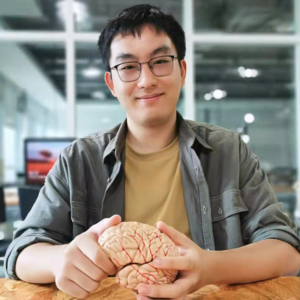
Qian Chu
Qian is interested in how brains construct models of the world and generate predictions to guide adaptive behaviour. He received his BS in neural science from New York University where his research focused on auditory prediction its relevance to the sense of agency. At the Max Planck – University of Toronto Centre (MPUTC) for Neural Science and Technology, he aims to decipher the predictive neural computations associated with saccadic eye movements. He is also into philosophy of mind and epistemology, especially the recent quantitative approaches (e.g., Bayesian epistemology).
MPUTC Project:
MPG Supervisor: Lucia Melloni, MPI: Empirical Aesthetics
U of T Supervisor: Taufik Valiante & Jose Zariffa, U of T Department: Institute of Biomedical Engineering (BME)
Thesis topic: Oculomotor representations in human medial temporal lobe
Research Theme: To analyze data, create models and make predictions about neural activity.
Project description:
Eye movements allow us to explore the world by shifting the visual field, yet it remains elusive how oculomotion interacts with visual perception as well as higher-level cognition like memory. Focusing on the medial temporal lobe (MTL) which was recently shown to respond to oculomotion (presumably mediated by a corollary discharge), this project aims at examining the perceptual and cognitive functions that arise from the structure during oculomotion. We view oculomotor signals as potential navigational signals for the “cognitive map” within the MTL, which generate strong hypotheses about predictive visual processing and memory. We plan to combine eye tracking, state-of-the-art single neuron recording, and electrical stimulation to investigate this topic in epilepsy patients when they perform a variety of cognitive tasks. Moreover, dynamic circuit models will be used to describe as well as predict neural data. The student will work in the labs of Prof. Taufik Valiante at the University of Toronto and Lucia Melloni at the Max Planck Institute for Empirical Aesthetics to approach the topic with multidisciplinary skill sets (e.g., eye tracking, psychophysics, systems and computational neuroscience). This collaborative project aims at opening new doors for research on sensorimotor integration and action-cognition interaction.
Nursima Ünver
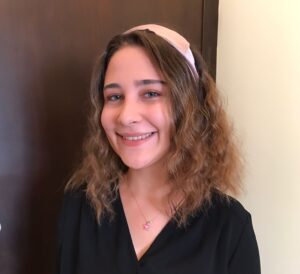
Nursima Ünver
Nursima received her BSc degree in psychology from Middle East Technical University, Turkey, and completed her MSc degree in psychology at Sabanci University, Turkey. Her research was focused on the costs of divided attention on long-term memory retrieval. For her Ph.D. research at MPUTC, she aims to investigate the adaptive and use-dependent nature of memories using different behavioral and neuroimaging techniques.
MPUTC Project:
MPG Supervisor: Rosanne Rademaker, MPI: Ernst Strüngmann Institute
for Neuroscience in Cooperation with Max Planck Society
U of T Supervisor: Keisuke Fukuda, U of T Department: Psychology
Thesis topic: Neural mechanisms of use-dependent working memory distortion
Research Theme: To analyze data, create models and make predictions about neural activity.
Project description:
Visual working memory (VWM) allows us to accurately hold in mind a limited amount of visual information so that it can be compared with new visual inputs. As such, VWM supports a wide range of goal-directed behaviors (e.g., identifying a suspect in a line-up). Dr. Rademaker identified that the human brain maintains multiple copies of a VWM representation in distinct coding formats across visual and parietal brain regions. This multiplexity ensures both flexibility and robustness of VWM representations as they are used in goal-directed behaviors. Nevertheless, VWM is susceptible to systematic distortions when making comparisons to new visual inputs, as demonstrated by Dr. Fukuda. Such memory distortions can result in grave consequences in real life (e.g., wrongful conviction due to inaccurate line-up identification). The current proposal aims to elucidate the neural mechanisms underlying VWM robustness and distortion. The supervisors’ shared expertise on computational techniques, and their independent expertise with neuroimaging techniques (fMRI for Dr. Rademaker; EEG for Dr. Fukuda) will enable the PhD student to investigate how VWM representations change over time across multiple brain regions as they are compared to visual inputs. This will allow us to predict and identify neural mechanisms responsible for memory distortions of practical importance.
Dallas Leavitt
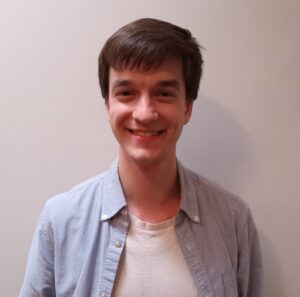
Dallas Leavitt
Dallas received his BSc from the University of Toronto where he investigated the ventral hippocampus in the context of approach-avoidance conflict decision making. After his undergraduate degree, he worked for a year in the Focused Ultrasound Lab at Sunnybrook Hospital where he contributed to the development of a novel conformal phased array system for transcranial focused ultrasound therapy. He is excited to be beginning his PhD with the MPUTC where he will study the substantia nigra and its role in cognitive and psychological symptoms of Parkinson’s Disease.
MPUTC Project:
MPG Supervisor: Peter Dayan & Alireza Gharabaghi, MPI: MPI for Biological Cybernetics in Tübingen
U of T Supervisor: Luka Milosevic, U of T Department: Institute of Biomedical Engineering (BME)
Thesis topic: The role of the substantia nigra in reward processing, impulsivity and apathy in Parkinson’s disease.
Research Theme: To analyze data, create models and make predictions about neural activity.
Project description:
Processing and learning about rewards is essential to operate in, and adapt successfully to, the environment. Impairments in these functions can contribute to cognitive and psychological disorders such as apathy, impulsivity and depression, e.g., in patients with Parkinson’s disease (PD). A key structure in reward processing and learning is the substantia nigra (SN), which is involved in the neuropathology of PD. Dopaminergic SN pars compacta neurons encode temporally-sophisticated reward prediction error signals in non-human primates and humans. Their phasic activity contributes to the learning of actions based on reward; their tonic activity has been suggested as providing motivational force by reporting the average reward rate. Such conclusions are consistent with the effects of SN manipulations in animals and in humans using deep brain stimulation.
Laura Kondrataviciute
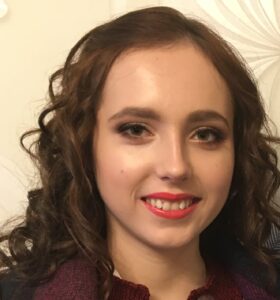
Laura Kondrataviciute
Laura is interested in wireless Deep Brain Stimulation which could be used to treat movement disorders associated with Parkinson’s disease, essential tremor, dystopia and other neurological conditions. She received her MEng degree in Chemical Engineering at the University of Bath, United Kingdom. Her research focused on synthesis and characterization of upconversion nanoparticles for size selective applications. At the Max Planck – University of Toronto Centre (MPUTC) Neural Science and Technology, Laura aims to develop micro/nano electrodes which could perform Deep Brain Stimulation wirelessly.
MPUTC Project:
MPG Supervisor: Metin Sitti, MPI: Physical Intelligence
U of T Supervisor: Taufik Valiante & Jose Zariffa, U of T Department: Institute of Biomedical Engineering (BME)
Thesis topic: Wireless Magnetopiezoelectic Micro/Nanomaterials-based Deep Brain Stimulation.
Research Theme:Develop novel tools to observe and stimulate neural activity.
Project description:
The project aims to conduct Deep Brain Stimulation wirelessly using magnetopiezoelectric nanoparticles and other micro/nanomaterials. Deep Brain Stimulation can be used to treat movement disorders associated with Parkinson’s disease, essential tremor, dystopia and other neurological conditions. The novelty of the project lies within piezoelectric part of electrodes, which could create electric charge wirelessly locally when external alternating and constant magnetic fields are applied on the magnetostrictive part of materials. Core-shell magnetopiezoelectric nanoparticles have shown initial promise on such wireless Deep Brain Stimulations. However, design, fabrication, precise control, and implementation of this technology require further investigation. By developing magnetopiezoelectric nanoparticles, the project could improve the health of people suffering from movement disorders.
Prerana Keerthi

Prerana Keerthi
Prerana completed her B.Eng in Electrical and Biomedical Engineering at McMaster University in 2023. She is interested in using signal processing and computational modelling techniques toward characterizing pathological circuits underlying various neurological conditions. Her interests additionally lie in applying this knowledge toward closed-loop neuromodulation therapies that use neurofeedback to inform stimulation. She is excited to start her PhD at the MPUTC, investigating the use of novel markers in closed-loop deep brain stimulation strategies to alleviate the symptoms of Parkinson’s disease.
MPUTC Project:
MPG Supervisor: Thomas Knösche & Wolf-Julian Neumann (Charité Berlin), MPI: MPI-CBS Leipzig
U of T Supervisor: Luka Milosevic, U of T Department: Institute of Biomedical Engineering (BME)
Thesis topic: Towards restoration of E:I balance in Parkinson’s disease and dystonia.
Research Theme: to analyze data, create models and make predictions about neural activity.
Project description:
Many brain circuits operate in a dynamic state governed by the balance between excitation and inhibition (E:I balance). Fluctuations in E:I balance underlie various physiological functions, while aberrant shifts have been implicated in neurological and psychiatric disorders. Recent computational work has estimated E:I changes from the power law exponent of electrophysiological power spectra, as validated by extracellular neural data in rats and macaques. However, these methods have not yet been validated at the single-unit level, nor have consequences on circuit communication been studied in humans. We propose to leverage this exciting methodology to study the implications of E:I balance in movement disorders. In particular, opposing shifts in E:I balance have been postulated to give rise to the hypo- and hyperkinetic symptoms in Parkinson’s disease and dystonia, respectively. We propose to leverage intracranial recordings (single-neuron, local-field-potential, electrocorticography, magnetoencephalography) from the human basal-ganglia-thalamo-cortical network (BGTCN) to validate such hypotheses, and to explore the possibility for therapeutic restoration of E:I balance by manipulation of BGTCN circuitry using deep brain stimulation. Furthermore, we will seek a deeper understanding of these processes by mechanistic modelling of the BGTCN network using neural mass models, linking E:I balance to behavioral consequences, electrophysiological activity, and brain stimulation.
Savina Cammalleri
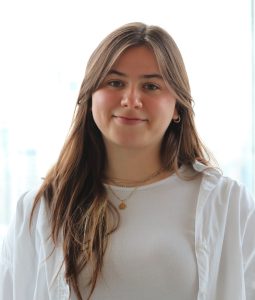
Savina Cammalleri
Savina is intrigued by understanding the cell heterogeneity in Alzheimer’s disease. She received her BSc from the University of Toronto in Molecular Genetics and Biochemistry. During her undergraduate her research focused on identifying novel nematicides for plant parasitic nematode control. In the Max Planck University of Toronto Centre program she aims to understand the differences in spatiotemporal transcriptomic profiles in ramified and amoeboid microglia in the context of Alzheimer’s using a novel technology, ex vivo-digital microfluidic isolation of single cells for -Omics (evDISCO).
MPUTC Project:
MPG Supervisor: Nils Brose & Olaf Jahn, MPI: MPI-NAT Göttingen
U of T Supervisor: Aaron Wheeler & Maryam Faiz, U of T Department: Institute of Biomedical Engineering (BME)
Thesis topic: Spatially Resolved and Single-Cell Proteomics to Assess Physiological Microglia States.
Research Theme: to conduct neurobiology experiments that use advance tools.
Project description:
We will develop a cutting-edge methodology – ex vivo digital microfluidic isolation of single cells for Omics (evDISCO) – to study transcriptomic and proteomic profiles of microglia in defined physiological states, focusing on functional consequences of neuronal inputs to microglia. Beyond their role in brain pathophysiology, microglia appear to also act as physiological regulators of brain function, by receiving specific input from surrounding neurons and feeding back regulatory information via chemical messengers and cell-cell contacts. We plan to explore the underlying biology by using evDISCO in microglia reporter mouse lines, focusing on the effects of neuronal signaling on microglia transcriptomes and proteomes in defined brain regions and single cells. To this end, our PhD student will comparatively profile microglia (i) from transmitter-secretion-deficient brains (organotypic Unc13 KO brain slices) to determine how overall circuit activity affects microglia states, and (ii) from multiple brain regions (e.g. frontal cortex, visual cortex, hippocampus, striatum, a.o.) to systematically assess how the specific neuronal environment defines specific microglia states. As the evDISCO approach circumvents the requirement of complex additional reporter lines (e.g. RiboTag or BioID), we expect that the planned PhD-project will rapidly provide deep insights into how microglia interact with neurons to co-define circuit function.
Filip Miscevic

FILIP MIŠČEVIĆ
Filip completed a B.Sc. in Neuroscience, Computer Science and Cognitive Science in 2015, and a M.Sc. in Applied Computing in 2022, at the University of Toronto. His research interests span computational neuroscience, cognitive modelling, and brain-computer interfaces (BCIs). At the Max Planck – University of Toronto Centre (MPUTC) for Neural Science and Technology, Filip aims to develop neurofeedback-based BCIs for improving speech perception and production by modulating auditory attention in sufferers of traumatic brain injury, Parkinson’s, developmental language disorders, and cochlear implant recipients.
MPUTC Project:
MPG Supervisor: Lars Meyer, MPI:Human Cognitive and Brain Sciences (Leipzig)
U of T Supervisor: Andrew Dimitrijevic , U of T Department: Institute of Biomedical Engineering (BME)
Thesis topic: Novel Brain-Computer Interfaces for Rehabilitating Top-down Control of Speech and Fine Motor Coordination.
Research Theme: to develop novel tools to observe and stimulate neural activity.
Project description:
Brain-Computer Interfaces (BCIs) are successful in domains where the human brain controls an external device (e.g., a prosthetic limb) or communicative devices in patients with severe motor disability (e.g., ALS). More recently, BCIs have shown promise as a neurorehabilitation tool for cognitive impairments with or without overt motor output (e.g., stroke, dementia), because they are thought to promote neural plasticity and brain reorganization. We propose to leverage advances in wearable technologies (e.g., wireless EEG) and biosignal processing/analysis methods (e.g., neural networks, machine learning) to develop advanced BCIs for real-world clinical applications. In the first project, an auditory BCI based on neural signatures of selective attention is developed to create a “cocktail party” listening BCI system for those with attention-related difficulties (e.g., people with cochlear implants, traumatic brain injury). The second project aims to develop a BCI that operates on the magnetoencephalogram of children suffering from Developmental Language Disorders; the BCI shall deliver control signals for a novel individualized auditory intervention that is already under development. Thirdly, we will develop a BCI to train patients with Parkinson’s disease to downregulate pathological oscillations that arise when exposed to stressful stimuli known to provoke akinesia/freezing.
Xin Mu
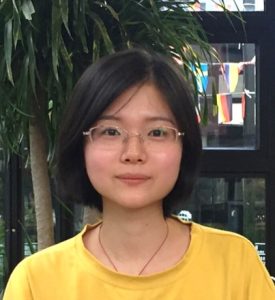
Xin Mu
Xin Mu is a MPUTC Joint Ph.D. student in Electrical and Computer Engineering at University of Toronto conducting her research at the Max Planck Institute of Microstructure Physics. Her current research interests are focused on implantable silicon photonic neural probes with microfluidic capability for chemical injection and sampling, optical grating emitters for photostimulation, and microelectrodes for electrophysiology recording.
MPUTC Project:
MPG Supervisor: Wesley Sacher, MPI: Microstructure Physics
U of T Supervisor: Joyce Poon, U of T Department: Electrical and Computer Engineering
Thesis topic: Implantable silicon photonic neural probes with microfluidics.
Research Theme: To develop novel tools to observe and stimulate neural activity;To conduct neurobiology experiments that use advance tools;To analyze data, create models and make predictions about neural activity;
Project description:
The implantable silicon photonic microfluidic neural probes can be deployed to deliver drugs at the target location with high spatial resolution, which can be helpful for neurodegenerative disease treatment.
Ankita Sharma

Ankita Sharma
Ankita Sharma is currently pursuing her MPUTC Joint Ph.D. in Electrical and Computer Engineering at the University of Toronto while conducting her research at the Max Planck Institute of Microstructure Physics. One of her primary research interests is designing integrated photonic circuits to probe the dynamics of neurons in the brain. Ankita earned her B.S. from the California Institute of Technology in 2018 and M.S. from ETH Zurich in 2020, both in the field of Electrical Engineering.
MPUTC Project:
MPG Supervisor: Wesley Sacher, MPI: Microstructure Physics
U of T Supervisor: Joyce Poon, U of T Department: Electrical and Computer Engineering
Thesis topic: Optical Phased Array Neural Probes for Beam Steering in Tissue.
Research Theme: To develop novel tools to observe and stimulate neural activity.
Project description:
This project aims to advance the field of neuroscience by developing novel Optical Phased Array (OPA) designs for integration in implantable silicon neural probes. Leveraging our group’s previous success with implantable probes featuring silicon nitride photonic waveguides, the focus now shifts to overcoming the limitation of multiple beam emissions from an OPA device. The proposed OPAs are designed for wide-angle, single-lobe beam steering at visible wavelengths, enhancing the precision of optogenetic stimulation within brain tissue. The project involves design, fabrication with our foundry partner, Advanced Micro Foundry, and testing in collaboration with neuroscientists.
